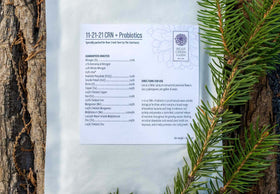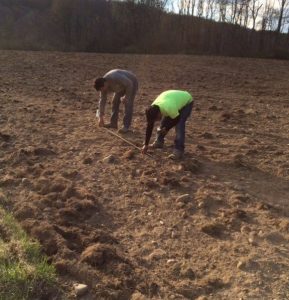Dowsing in Dutchess County

Before returning to New York and to Stanfordville, I lived for many years in various European cities. As an expat, to survive and thrive in an overseas environment, I had to be open to new ideas and unfamiliar ways of doing things. These lessons have served me well as I slowly transform Bear Creek Farm into a commercial dahlia farm.
Because, in truth, as a confirmed Manhattanite and neophyte farmer, to me agriculture was at first a foreign enterprise, even though dahlias are a forgiving crop that is easy to grow. It begins with plump, firm tubers from good stock that you plant—in upstate New York—in mid- to late May, after the threat of frost.
You need good topsoil, enriched with fertilizer, to plant the tubers approximately six inches under in an area that gets good sun for at least six hours a day. After that, it’s a good idea to mound the soil up to once the dahlias start coming out of the ground. Space the tubers eighteen to twenty-four inches apart in straight rows to make staking them easier.
Now comes the hard part: do nothing. That’s right. Leave the tubers alone; do not water them! At this point water does more harm than good, because the tubers are susceptible to rot. Go about your business until you see small green shoots, and then—and only then—should you begin to water. And once you start watering, it seems you never stop. Growing dahlias like a good long soaking three times per week, more if you live in a particularly dry climate.
So far, so good. Or so I thought as I planned my first Bear Creek Farm dahlia crop. What I did not plan on, however, was difficulty in finding water to hydrate thousands of tubers. The Bear Creek Farm well supplied ample water for household and vegetable and a lovely flower garden needs, but it would not be sufficient to meet the demands of a working farm.
I would need a minimum 35 gallons per minute (gpm) to irrigate the first field of dahlias and furnish water for the barn Steve and I were converting to an entertainment space and guest house. The bad news was that such a robust flow of well water is pretty much not easy to find in this part of Dutchess County. So, I called in the experts who drill wells. They told me: 1) forget it—you’re never going to get 35 gpm around here; 2) we can look, but we’ll need to drill several holes to get to that amount, and it’s going to cost you anywhere from ten to thirty grand for each hole because we have no idea how deep we have to go; 3) and by the way—we have no idea where to begin.
So much for expert advice. It was time to look for another solution. Bear Creek Farm needed a new well, and I was going to have to find a way to get one at a cost what would not bankrupt us. I decided to forego the high-tech “solutions” proposed by the drillers to bore random holes on my farm in the hopes of finding water and follow instead the offhand suggestion thrown out by one of them when it was pretty clear I wasn’t buying into plan A: “you should hire a dowser, lady.”
So I did. I hired a water witch, or, more properly, a dowser, to find the right spot for a productive well to water the our soon to be prized (I hope!) dahlias. Dowsing—finding water or the best place to drill a well through the use of a forked stick called a “divining rod”—has been a long-accepted practice in the Hudson Valley. And Don Spohr, the guy I hired, is considered the dean of upstate dowsers. Rugged and weathered in a way that suggest he’s spent most of his 80-plus years in the outdoors, Don arrived at Bear Creek Farm with tools of his trade, a wire implement that looked like a stretched and twisted coat hanger and a wooden stick with a ball bobbing on the end of it. Turns out, Don knew the property as well as I do: as a boy he’d played baseball in its abandoned orchards and fields. After cautioning me that finding a spot where water would flow at 35 gpm would be a challenge, he got to work.
At this point, I was still something of a skeptic, so as Don walked the land clutching his wooden stick, I kept my eyes glued to his hands. Every so often the ball at the end of the stick would bobble, but the movement was not due to anything Don had done. His wrists remained rigid: something else was causing the ball to move. Occasionally Don would linger over a spot where, he said, a well so many feet deep would produce 14 or 15 gpm, not enough to meet the irrigation needs. Don was beginning to be doubtful and I was getting more and more worried. At last we approached the site just 20 feet from the last where Don had said that might have been our best bet at about 30 gpm and Don froze. Tell your drillers to drill here, he said, and at feet they’ll find 14 gpm at 155 feet; if they drill exactly another 20 feet more, they will hit another vein of water at 35 gpm.
You probably already know the end of this story: Don’s prediction turned out to be precisely right. The drillers found two veins, one producing 35 gpm and the other 15 gpm, for a whopping total of 50 gpm, enough water to irrigate and support the barn project with some left over to spare. The one thing Don got wrong was the order in which the drillers found the veins, which to my mind is immaterial. He saved us tens of thousands of dollars and untold headaches.
Is dowsing a science? An art? Magic? I don’t think it matters what you call it. I call it effective, and I have 50 gallons per minute to prove it!







